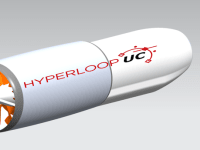With our world becoming more interconnected, transportation and distribution are vital. With this versatile Hyperloop design, both supersonic pedestrian transport and incredibly fast and efficient product distribution are possible. Hyperloop consists of a pod or capsule inside a tube. To overcome the Kantrowitz limit for the Hyperloop, counter rotating fans on the nose actively bypass flow through the pod, transferring high pressure air from the front to the rear of the vehicle. Moreover, this aerodynamic system provides a higher pressure ratio, lesser power requirement, and lesser weight for the system as a whole. The fans serve other purposes, solving the issue of creating a low friction suspension system at near sonic speeds (proving to work at speeds of Mach 1.1 with little to no friction), and negating torque due to the fans on the craft. External linear induction motors accelerating the pod would quickly allow subsonic speeds to be reached. Magnetic levitation with the pod is achieved using hover engines. Using a Halbach magnet array would allow for efficient and safe braking of the pod, requiring no input energy or power for cooling. Hyperloop provides the safest mode of transport as no confounding variables can affect its travel. Additionally, delays will be a thing of the past as weather concerns are of no issue with the tube, drastically increasing time transit.
Economics: Costs of the pod production along with its linear induction motors would be minor to that of the depressurized tube itself. However, mounted solar panels on the top of the tube would generate more than enough energy needed for operation, rendering Hyperloop self-sustaining after initial costs, and making it the most sustainable and efficient transportation mode to date.
Pedestrian Transport: Pedestrian Hyperloops would be to and from major cities, as the potential of the transportation system would be wasted on shorter distance trips. With the ability to travel over 700 miles an hour, work commutes would be across countries. This would allow someone to live in affordable housing, but not be near their place of business - encouraging cooperation and connecting economic and cultural centers, making for a more united world.
Distribution: By placing Hyperloops between distribution centers all strategically located near airports and major cities (LA, Denver, Chicago, etc..), free from traffic and all other unforeseen confounding variables, increased product flow would be promoted. For distribution and cargo loads, the Hyperloop pod would have no need for subsonic speeds, saving greatly on the cost of vacuuming the tube. The pod itself would also be cheaper as most cargo does not require a pressurized cabin. With many distribution centers using semi-trucks as their main source of product circulation, countless hours of labour would be saved as well as drastically decreasing use of fossil fuels.
We are currently working with local companies to plan potential concept projects. In addition, Hyperloop UC also won the Hamdan bin Mohammed Award for Innovation in Project Management. Corporate sponsors include Ansys, Siemens, Workhorse, and The University of Cincinnati. Hyperloop will modernize the future.
Video
Like this entry?
-
About the Entrant
- Name:Noah Darwiche
- Type of entry:teamTeam members:Noah Darwiche
Heath Palmer
Shaaban Abdallah
Hyperloop UC - Software used for this entry:Ansys, Compsol, Arduino (IDE), Solidworks, Hypermesh, C, C++, HTML, CSS, JavaScript, Java
- Patent status:none








